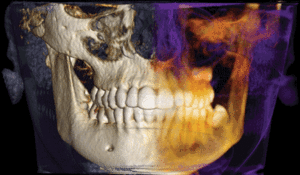
Precise view into your patient's anatomy and tools to plan their care.
Doctors have come to trust Imaging Sciences because of their reputation for knowing precisely what dentists need to improve clinical control and workflow. In contemporary dental practices, both general dentists and specialists are increasingly adding implants and other surgical procedures. 3D imaging is a tool that boosts the efficiency and success of the process. The new i-CAT® Precise™ was specifically designed for implant and oral surgery procedures with the award-winning i-CAT® technology.
Powerful Treatment Tools
This new dynamic system is equipped with tools for treatment planning and implementation, as well as patient education. With the exclusive Tx Studio™ treatment planning solution, dentists can feel confident in accurately planning the entire implant process, including single and multiple implant placement and the restorative treatment for these implants. The high resolution, volumetric images give the clinician the data to analyze and measure exact bone structure, discern buccolingual dimensions, concavities, bone height, and view tooth orientation in the planning stage. From the surgical placement of the implant to the final restoration, the scope of information obtained from i-CAT Precise provides dentists with a concise map of the entire course of treatment. The new i-CAT Precise also helps dentists to incorporate the latest dental techniques without the stress of guessing. Steven A. Guttenberg, DDS, MD, elaborates on the value of 3D imaging for implants. “CBCT offers me the data to evaluate potential implant sites, and develop a treatment plan. I can place implants exactly, avoiding anatomical structures, such as the sinuses and nerves, and I can establish precise angles to fit the implant properly in the available bone. With CBCT, my patients’ confidence grows and so does as my confidence to treat them properly and safely.”

Faster 3D Workflow
With all of the details to keep track of during an implant or surgical process, having a method of increasing efficiency and accuracy is comforting to the doctor and the patient. The scan is captured, reconstructed, and ready for planning in less than 30 seconds. Even complex treatment plans can be completed in a few minutes with the Tx Studio software and immediately discussed either chairside or in consultation rooms. With the opportunity to view rich, engaging 3D visual images, patients will quickly understand reasons for treatment and be eager to start the process.
More Clinical Control
Practices strive to make patients feel special in many ways, so why not also with imaging? Because patients are not “one-scan-fits-all,” i-CAT Precise gives the clinician control over image size and radiation dose—each scan can be designed for the individual needs of each patient. Capture a single arch to full dentition plus the TMJ complex with 3D scans of 8cm or 14cm diameters and heights ranging from 8cm to 2cm and everything in between. With Precise, dentists and staff can proudly tell the patient that the system was chosen with an eye for the lowest radiation exposure while still obtaining the necessary amount of information. And, for those times when a pan is indicated, the i-PAN™ option captures traditional 2D panoramic images without having to invest in two separate sensors or machines. Learn more about the new i-CAT Precise at http://www.imagingsciences.com/products/i-cat-precise/.
